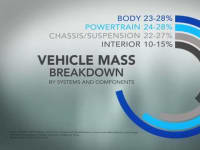The exigent global energy shortage and air pollution problem is also affecting our prosperity. One way to address both of these issues is to make carbon-fuel-utilization more efficient. Vehicle lightweighting is part of the strategy because hundreds of millions of tons of vehicle material are moved around unnecessarily, wasting energy and producing pollution. Revolutionary thinking will have to take place to affect new paradigms starting with ultra- light and ultra-efficient “Near-Zero” emission propulsion plant submitted here this and last year also->http://www.atlasmotorworks.com/dev/index.php and utilization of stronger, lighter, energy extensive, renewable plastics for durable light-weight body.
The power train must be the starting area for lightweighting because it forms the basis for subsequent weight reductions in other areas. Our wheel mounted rotary engines are able to achieve specific-power of 5-10hp/lb which is 10 times better than legacy-piston-engines, dispensing with cooling system and drive-train-transmission. A 50lb engine can produce 250-500hp and >1000lb-ft of torque. An air or hydrostatic accumulator, for brake energy recovery and other purposes, can serve as backbone-chassis-frame.
3D structures, such as trusses or lattices, have higher specific strength [strength per unit of material] and therefore form lighter structures able to withstand same forces compared to solid materials. This also allows structures to be more cost effective. Today’s car manufacturing vaguely utilizes this construct. It is also well known that elastic materials and structures absorb/dissipate energy better than rigid or solid ones.
Proposed here is a thick walled auxetic/chiral foam body [perhaps 6 inches thick] over an auxetic/chiral 3D truss/lattice superstructure with no conventional frame,
A 40 mph crash test of the vehicle, which was constructed of conventional foam, resulted in half the stress on seatbelts compared to current safety standards.
Initially the choice of material may be auxetic foam over extruded auxetic 3D superstructure made of ultra- high-molecular-weight polyethylene [UHMWPE] or other UHMW polymer. The superstructure units are cut into slabs, shaped, overlaid/filled with auxetic foam. Process is similar to high precision injection molding and could produce a surface not requiring additional finishing. Alternately the units can be covered by any number of finishes/skins such as shrink wrapping. Reinforcing sandwich panels are possible to create for strategic locations. Closed cell auxetic foam would be ideal, providing additional form of energy absorption. High strength shrink wrapping creates even stronger and more energy absorbing building units. 3D printing can ultimately be used.
A >50% weight savings can be realized coupled with the our rotary engine can produce a >150mph vehicle
Main Innovations
• ultra compact & efficient engines with novel air cycle(s)
• in-wheel mounted engine(s) or motor(s)
• thick walled auxetic foam over extruded (for the near term) auxetic 3D superstructure elements
• low cost, low processing energy, high mfg speed, renewable, UHMW polymer (for the near term)
• vehicle structural wall enhancements
• significant pedestrian, motorcyclist and bicyclist safety enhancement via foam exterior
• superior sound and thermal insulation
• inherently an amphibious vehicle capable of becoming a flying amphibious VTOL vehicle
Like this entry?
-
About the Entrant
- Name:Milan Krupa
- Type of entry:individual
- Patent status:pending








